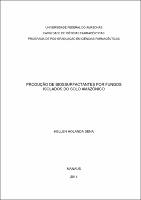| ???jsp.display-item.social.title??? |


|
Please use this identifier to cite or link to this item:
https://tede.ufam.edu.br/handle/tede/4706| ???metadata.dc.type???: | Dissertação |
| Title: | Produção de biossurfactantes por fungos isolados do solo amazônico |
| ???metadata.dc.creator???: | Sena , Hellen Holanda  |
| ???metadata.dc.contributor.advisor1???: | Souza, João Vicente Braga de |
| ???metadata.dc.description.resumo???: | Os surfactantes são muito demandados pelas indústrias farmacêutica, alimentos e de petróleo. Os surfactantes sintéticos, que são convencionamente utilizados, apresentam problemas relacionados a sua toxicidade e recalcitrância. Isso aumenta o interesse nos surfactantes de origem natural produzidos por micro-organismos (biossurfactantes). Poucos trabalhos foram realizados investigando a produção dessas subtâncias por fungos isolados da Região Amazônica. Diante dessa situação, o presente trabalho investigou a produção de biossurfactantes por fungos isolados de solo da floresta amazônica. Foi realizado o isolamento de micro-organismos de amostras de solo do Bosque do Instituto Nacional de Pesquisas da Amazônia pelo método de diluições sucessivas. A identificação dos isolados foi realizada investigando-se as características micromorfológicas das colônias (técnica de microcultivo). Para seleção dos isolados produtores de biossurfactantes, os mesmos foram cultivados em bioprocesso submerso e os filtrados das culturas foram submetidos à investigação pelas técnicas de colapso da gota e índice de emulsificação. O isolado selecionado foi submetido à otimização da produção do biossurfactante por meio de um delineamento fatorial 24 a fim de avaliar a influência da concentração das fontes de carbono e nitrogênio utilizadas, bem como, pH e tempo de tratamento das amostras. Por fim, o biossurfactante produzido pelo isolado selecionado foi semi-purificado e submetido a ensaios de estabilidade térmica e iônica. A partir dos métodos desenvolvidos, foi possível isolar 100 amostras fúngicas, das quais, 9 apresentaram bom índice de emulsificação (E24>40) e Penicillium 8CC2 foi considerado o melhor produtor de biosurfactante. A investigação da influência dos fatores do bioprocesso mostraram que a melhor condição para obtenção de biossurfactante foi utilizando óleo de soja (20 g/L), extrato de levedura (30g/L), pH 6,0 por 9 dias. A avaliação da estabilidade térmica (100°C por 60 min) e iônica (NaCl 30%) demonstrou que nenhum dos dois fatores desestabilizaram o emulsificado produzido. As principais contribuições aqui alcançadas no presente trabalho foram o isolamento da linhagem produtora biossurfactante de Penicillium 8CC2 e a definição preliminar dos parâmetros de bioprocesso |
| Abstract: | Surfactants play an important hole in pharmaceutical, food and oil industries. Synthetic surfactants have been presenting problems related to their toxicity and recalcitrance. This situation increases the interest on natural surfactants produced by microorganisms (biosurfactants). Just a few studies were conducted investigating the production of these substances by fungi isolated from the Amazon region. The aim of this study was investigate the production of biosurfactants by fungi isolated from soil in the Amazon forest. The isolation of micro-organisms of the soil samples was performed by the method of successive dilutions. The identification of the isolates was performed by investigating the micromorphological characteristics (microculture technique). For selection of biosurfactants producers, the strains were submitted submerged bioprocess and the filtrated from the cultures were subjected to investigation by techniques “collapse of the drop” and “emulsification index”. The selected isolate was subjected to optimize the production of the biosurfactant by a factorial design 24 evaluating the influence of the concentration of carbon and nitrogen sources, pH and bioprocess time. Finally, the biosurfactant produced by the selected strain was semi-purified and tested for stability (thermal and ionic). It was isolated 100 fungal strains, 9 of them showed good emulsification index (E24> 40) and Penicillium 8CC2 was screened as the best biosurfactant producer. The investigation of the influence of the bioprocess factors showed that the best condition for obtaining the biosurfactant was by using soybean oil (20 g/L), yeast extract (30 g/L) pH 6.0 and 9 days. The evaluation of thermal (100 ° C for 60 min) and ionic (30% NaCl) stability showed that none of the two factors destabilized emulsified produced. The main contributions that were achieved in the present work was the isolation of biosurfactant producer Penicillium 8CC2 and a preliminary definition of bioprocess parameters. |
| Keywords: | Biossurfactantes Fungos Emulsificante |
| ???metadata.dc.subject.cnpq???: | CIÊNCIAS DA SAÚDE: FARMÁCIA |
| Language: | por |
| ???metadata.dc.publisher.country???: | Brasil |
| Publisher: | Universidade Federal do Amazonas |
| ???metadata.dc.publisher.initials???: | UFAM |
| ???metadata.dc.publisher.department???: | Faculdade de Ciências Farmacêuticas |
| ???metadata.dc.publisher.program???: | Programa de Pós-graduação em Ciências Farmacêuticas |
| Citation: | SENA. Hellen Holanda. Produção de biossurfactantes por fungos isolados do solo amazônico. 2014. 67f. Dissertação (Mestrado em Ciências Farmacêuticas) - Universidade Federal do Amazonas, Manaus, 2014. |
| ???metadata.dc.rights???: | Acesso Aberto |
| URI: | http://tede.ufam.edu.br/handle/tede/4706 |
| Issue Date: | 29-Aug-2014 |
| Appears in Collections: | Mestrado em Ciências Farmacêuticas |
Files in This Item:
| File | Description | Size | Format | |
|---|---|---|---|---|
| Dissertação_Hellen H. Sena.pdf | 911.27 kB | Adobe PDF |  Download/Open Preview |
Items in DSpace are protected by copyright, with all rights reserved, unless otherwise indicated.




